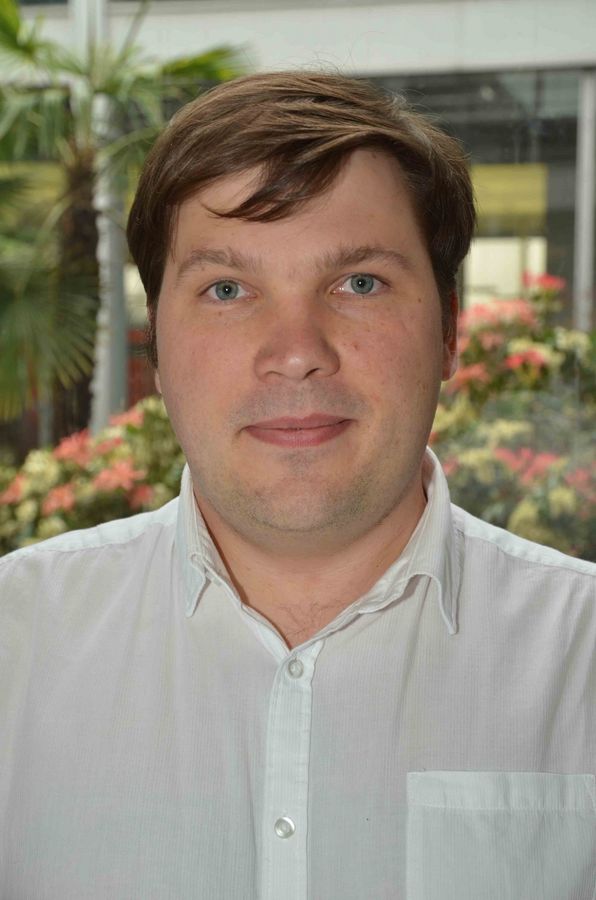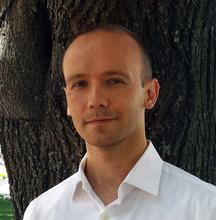This page provides information about the previous schedule of the Leipzig Spin Resonance Colloquium in autumn 2022/2023.
Current Program
When small is beautiful in magnetic resonance
For select applications, and especially when samples are naturally small, or small for technical reasons, the NMR system must accomodate this vanishing sample size, which implies the use of miniaturized detection and sample handling sub-systems. In my presentation I will thus address the challenge of achieving the required miniaturization of NMR hardware for sample sizes of around one microlitre and less. I will illustrate the ways we gain control over the patterning of NMR-compatible materials at the microscale, and discuss some of the detection (sub-) systems that my group has established with these processes over the past five years or so. This will include a demonstration of the sort of measurements we can achieve by these systems.
Genes, Cells, and Magnetic Resonance Imaging
Magnetic resonance imaging (MRI) has become a powerful non-invasive tool to investigate human brain structure in health and disease. Numerous MRI techniques are used in clinical practice to create so-called weightedimages (e.g. diffusion-weighted, T1-, T2- or T2*-relaxation weighted) that accentuate different brain structures and pathologies. More detailed information can be obtained from quantitative (q) MRI approaches (e.g. measuring water molecule diffusion or relaxation rate/time parameters) that are more specific to different aspects of brain tissue microstructure than weighted (w) approaches.
Development quantitative MRI requires deep understanding of underlying biophysical mechanisms relating MRI signal to tissue microstructure. Work in my lab has always been focused on this direction - revealing new biophysical mechanisms underlying MRI signal and using these mechanisms for developing new MRI-based techniques to study biological tissue structure and functioning. In this talk I will discuss our results related to developing quantitative Gradient Recalled Echo (qGRE) technique that links MRI signal with brain genetic and cellular microstructure and brain functioning in healthy people and patients with brain diseases, including Alzheimer disease and Multiple sclerosis.
The qGRE technique provides quantitative, non-invasive, in vivo, 3D measurements of several brain-tissue-specific relaxation properties (qGRE metrics) of the gradient recalled echo (GRE) MRI signal that depend on brain cellular structure and function. Specifically, qGRE separates the GRE MRI signal decay R2* (=1/T2*) into its two main components, R2t* (t stands for tissue) and R2′. The R2′ component relates to the GRE signal loss due to the mesoscopic through-space effect of the paramagnetic deoxyhemoglobin in venous blood and an adjacent part of the capillary bed (BOLD effect) (1,2). The R2t* relaxation parameter depends on the environment of water molecules mainly at the tissue cellular/membrane (3,4) and non-heme iron (5,6) levels. The established genetically defined relationship between R2t* and tissue cellular structure (3) opened opportunity for establishing the role of the human brain neuron-glia-synapse composition in forming resting-state functional connectivity networks (7).
qGRE is based on a (i) 3D GRE MRI sequence with multiple gradient echoes (currently available from most MRI scanner manufacturers), (ii) a post-processing method (8) for separation of tissue microstructural and BOLD contributions, as well as contributions from non-specific to tissue properties background B0 field inhomogeneities (9)and physiological fluctuations (10) to GRE signal, (iii) a genetically-informed quantitative relationship that we have derived between qGRE R2t* metric and tissue cellular structure (3).
1. Ogawa S, Lee TM, Kay AR, Tank DW. Brain magnetic resonance imaging with contrast dependent on blood oxygenation. Proceedings of the National Academy of Sciences of the United States of America 1990;87(24):9868-9872.
2. Yablonskiy DA, Haacke EM. Theory of NMR signal behavior in magnetically inhomogeneous tissues: the static dephasing regime. Magn Reson Med 1994;32(6):749-763.
3. Wen J, Goyal MS, Astafiev SV, Raichle ME, Yablonskiy DA. Genetically defined cellular correlates of the baseline brain MRI signal. Proc Natl Acad Sci U S A 2018;115(41):E9727-E9736.
4. Sukstanskii AL, Yablonskiy DA. Microscopic theory of spin–spin and spin–lattice relaxation of bound protons in cellular and myelin membranes–a lateral diffusion model (LDM). Magnetic Resonance in Medicine 2022;n/a(n/a).
5. Yablonskiy DA, Wen J, Kothapalli SVVN, Sukstanskii AL. In vivo evaluation of heme and non-heme iron content and neuronal density in human basal ganglia. NeuroImage 2021;235:118012.
6. Sukstanskii AL, Yablonskiy DA. Gaussian approximation in the theory of MR signal formation in the presence of structure-specific magnetic field inhomogeneities. J Magn Reson 2003;163(2):236-247.
7. Kahali S, Raichle ME, Yablonskiy DA. The Role of the Human Brain Neuron-Glia-Synapse Composition in Forming Resting-State Functional Connectivity Networks. Brain Sciences 2021;11(12):1565.
8. Ulrich X, Yablonskiy DA. Separation of cellular and BOLD contributions to T2* signal relaxation. Magnetic resonance in medicine 2016;75(2):606-615.
9. Yablonskiy DA, Sukstanskii AL, Luo J, Wang X. Voxel spread function method for correction of magnetic field inhomogeneity effects in quantitative gradient-echo-based MRI. Magn Reson Med 2013;70(5):1283-1292.
10. Wen J, Cross AH, Yablonskiy DA. On the role of physiological fluctuations in quantitative gradient echo MRI: implications for GEPCI, QSM, and SWI. Magn Reson Med 2015;73(1):195-203.
Profile
Symmetry-Based NMR Pulse Sequences in Solids and Liquids
NMR pulse sequences may be designed in such a way that they impose a symmetrical pattern in time and space on the nuclear spin dynamics. This approach leads to selection rules on the average Hamiltonian, which governs the main operating principle of the pulse sequence. The selection rules depend on a small set of integers, called symmetry numbers, which may be chosen to select terms of interest while suppressing the effect of interfering terms. In magic-angle-spinning solid-state NMR, this approach has been used for some time, to implement robust solutions to a variety of problems, such as double-quantum and zero-quantum dipolar recoupling, and the recoupling of chemical shift anisotropy interactions.
Recently, we have shown that the symmetry-based approach to pulse sequence design is also useful for certain spin dynamical problems in solution NMR. These include the robust conversion of magnetization to long-lived singlet order in near-equivalent spin-pair systems. We show that the PulsePol sequence, which has been used for a variety of tasks in nitrogen-vacancy magnetometry, may be understood as a riffled version of a symmetry-based pulse sequence, and used for robust singlet-triplet conversion in solution NMR.
In my talk I will review the principles of symmetry-based pulse sequence design and discuss how this approach leads to rapid and general solutions to a variety of spin dynamical problems in both solution NMR and solid-state NMR.
For our recent paper see http://arxiv.org/abs/2206.07109
Profile
For more information please visit the Matysik working group.
Find out more information about Buß- und Bettag.
Hyperpolarization with parahydrogen
Since many years PHIP (Parahydrogen Induced Polarization) and its reversible variant SABRE (Signal Amplification By Reversible Exchange) are among the most versatile tools for NMR signal enhancement in solution NMR. In the present talk we first give a short introduction into PHIP and SABRE, followed by several examples from our recent work. The first example shows results from our investigations of a bioactive derivative of the sunflower trypsin inhibitor-1 (SFTI-1), which inhibits matriptase, a colon cancer related enzyme. The PHIP activity of the inhibitor was achieved by labeling the tetradecapeptide with O-propargyl-L-tyrosine. Employing a carefully optimized automatized PHIP setup [1] in 1D-PHIP experiments an enhancement of up to ca. 1200 compared to normal NMR was found.[2,3] This huge enhancement factor permitted the ultrafast single scan detection of 2D-TOCSY spectra of micromole solutions of the PHIP labelled inhibitor.[3] The second example discusses the application of parahydrogen for the detection of low-concentrated intermediates of hydrogenation reactions via the PANEL (PArtial NEgative Line experiment).[4] The third example describes some recent results on substituent influences on the SABRE activity of Iridium complexes with heterocyclic carbene ligands.[5] Then we present recent results on the hyperpolarization of fumarate[6] and eptifibatide,[7] an antiplatelet aggregation inhibitor, which derives from the venom of certain rattlesnakes
[1] A. Kiryutin, G. Sauer, S.Hadjiali, A. V. Yurkovskaya, H. Breitzke, G. Buntkowsky* J. Magn. Res., (2017), 285, 26-36.
[2] G. Sauer, D. Nasu, D.Tietze, T. Gutmann, S. Englert, O. Avrutina, H. Kolmar*, G. Buntkowsky*,
Angewandte Chemie Int.Ed., (2014), 53, 12941-12945.
[3] A. S. Kiryutin, G. Sauer, D. Tietze, M. Brodrecht, S. Knecht, A.V. Yurkovskaya, K.L. Ivanov, O. Avrutina, H. Kolmar, G. Buntkowsky *, Chemistry Eur. J., (2019), 25,4025-4030.
[4] A. S. Kiryutin, G. Sauer, A. V. Yurkovskaya, H.-H. Limbach, K. L. Ivanov*, G. Buntkowsky*
J. Phys. Chem. C, (2017), 121, 9879-9888.
[5] S. Knecht, S. Hadjiali, D.A. Barskiy, A. Pines, G. Sauer, A. S. Kiryutin, K. L. Ivanov, A. V. Yurkovskaya , G. Buntkowsky*,J.Phys.Chem.C (2019), 123, 16288-16293.
[6] a) J. Eills,*, E. Cavallari, R. Kirchner, G. Di Matteo, C. Carrera, L. Dagys, M. H. Levitt, K. Ivanov, S. Aime, F. Reineri, K. Münnemann, D. Budker, G. Buntkowsky,*, S. Knecht*, Angewandte Chemie Int. Ed. (2021), 60, 6791-6798; b) S. Knecht, J.Blanchard, D. Barskiy, E. Cavallari, L. Dagys, E. van Dyke, M. Tsukanov ,B. Bliemel, K. Muennemann, S. Aime, F. Reineri, M. Levitt, G. Buntkowsky, A. Pines, P. Blümler, D. Budker, J. Eills, Proc. Nat. Acad. Sci. USA (2021), 118, 1-6; c) L. Wienands, F. Theiß, J. Eills, L. Rösler, S. Knecht*, G. Buntkowsky*, Appl. Magn. Res. (2021) 53, 615 - 634
[7] M. Fleckenstein, K. Herr, F. Theiß, S. Knecht, L. Wienands, M. Brodrecht, M. Reggelin,* G. Buntkowsky* Scientific Reports (2022), 12, 2337.
Profile
Towards new modalities of probing the microstructure at very high b-values
Modern clinical and animal MRI scanners offer versatile options for diffusion MRI, including very high b-values1-2. For instance, the b-values as high as 300 000 s/mm2 have been used for in vivo rat brain imaging3, in contrast to a typical range up to few thousand of s/mm2 used in conventional dMRI. At such high b-values, conventional perturbative descriptions and related bi-exponential, kurtosis, Kärger, and similar models become inapplicable4. Their failure and the emergence of the so-called localization regime were predicted in 1990s for one-dimensional domains5 and higher-dimensional bounded domains6. However, these important works remain underappreciated even nowadays, probably because of the sophisticated mathematics involved7. In this talk, I summarize more recent theoretical and experimental advances8-14 that extend the range of applicability of the localization regime and pave the way to new modalities for probing the microstructure at very high b-values.
In particular, I argue that the Gaussian paradigm generically fails at high gradients. This failure originates from the non-self-adjointness of the Bloch-Torrey operator that governs the time evolution of the transverse magnetization. The localization regime is shown to generically emerge at high-amplitude (non-narrow) gradients in any nontrivial domain, regardless whether it is bounded or not, permeable or not. Since the transverse magnetization is localized near microscopic boundaries (e.g., of cells or cellular organelles), the signal can potentially reveal their microstructure (e.g., effective sizes and mutual arrangement) and become very sensitive to the permeability. I emphasize that the localization regime and its features are accessible under ordinary, routinely used experimental conditions on clinical and animal MRI scanners. If the emergence of the localization regime remained unnoticed, deviations from the straight line of ln(S) at high b-values could be wrongly interpreted. While the advantages of the localization regime are not yet fully exploitable in biological samples due to signal-to-noise limitations, further developments of a non-perturbative theory of signal formation are necessary to predict, quantify and eliminate potential artifacts in clinical dMRI that are caused by the localization regime.
References
1. V. J. Wedeen, D. L. Rosene, R. Wang, G. Dai, F. Mortazavi, P. Hagmann, J. H. Kaas, and W.-Y. I. Tseng, The Geometric Structure of the Brain Fiber Pathways, Science 335, 1628 (2012).
2. D. S. Novikov, E. Fieremans, S. N. Jespersen, and V. G. Kiselev, Quantifying brain microstructure with diffusion MRI: Theory and parameter estimation, NMR Biomed. e3998 (2018).
3. J. Pfeuffer, S. Provencher, R. Gruetter, Water diffusion in rat brain in vivo as detected at very large b values is multicompartmental, Magn. Reson. Mat. Phys. Biol. Med. 8, 98 (1999).
4. D. S. Grebenkov, NMR Survey of Reflected Brownian Motion, Rev. Mod. Phys. 79, 1077 (2007).
5. S. D. Stoller, W. Happer, and F. J. Dyson, Transverse spin relaxation in inhomogeneous magnetic fields, Phys. Rev. A 44, 7459 (1991).
6. T. M. de Swiet and P. N. Sen, Decay of nuclear magnetization by bounded diffusion in a constant field gradient, J. Chem. Phys. 100, 5597 (1994).
7. D. S. Grebenkov, Diffusion MRI/NMR at high gradients: challenges and perspectives, Micro. Meso. Mater. 269, 79 (2018).
8. D. S. Grebenkov, Exploring diffusion across permeable barriers at high gradients. II. Localization regime, J. Magn. Reson. 248, 164 (2014).
9. M. Herberthson, E. Ozarslan, H. Knutsson, C.-F. Westin, Dynamics of local magnetization in the eigenbasis of the Bloch-Torrey operator, J. Chem. Phys. 146, 124201 (2017).
10. D. S. Grebenkov and B. Helffer, On spectral properties of the Bloch-Torrey operator in two dimensions, SIAM J. Math. Anal. 50, 622-676 (2018).
11. Y. Almog, D. S. Grebenkov, and B. Helffer, Spectral semi-classical analysis of a complex Schrödinger operator in exterior domains, J. Math. Phys. 59, 041501 (2018).
12. N. Moutal, K. Demberg, D. S. Grebenkov, and T. A. Kuder, Localization regime in diffusion NMR: theory and experiments, J. Magn. Reson. 305, 162-174 (2019).
13. N. Moutal and D. S. Grebenkov, The localization regime in a nutshell, J. Magn. Reson. 320, 106836 (2020).
14. N. Moutal, A. Moutal, and D. S. Grebenkov, Diffusion NMR in periodic media: efficient computation and spectral properties, J. Phys. A: Math. Theor. 53, 325201 (2020)
Profile
Denis GREBENKOV has graduated from Saint Petersburg State University and Ecole Polytechnique after defending two PhD theses, one in statistical and the other in theoretical physics. Since 2006, Denis GREBENKOV is a permanent CNRS researcher at Laboratory of Condensed Matter Physics of Ecole Polytechnique. He is interested in understanding and modeling transport phenomena in complex systems. He developed various models, theoretical approaches and numerical tools for studying Laplacian transport towards irregular interfaces, anomalous diffusions in living cells, first passage times of intermittent surface-mediated processes in porous media, diffusion magnetic resonance imaging of lungs and brain, convective and diffusive transport in the placenta, to name a few
More information may be found HERE
MAGNETOM Free.Max at UM: The First 18 Months at 0.55T
Commercial low-field (0.55T) whole body systems have recently been introduced for clinical MRI, and MIITT in the Department of Radiology at the University of Michigan obtained one such system for exploratory purposes in April 2021. These systems, designed to be lower cost alternatives to higher field MRI scanners, are meant to be deployed both in conventional Radiology Departments but also in unconventional settings such as the Emergency Department. However, because they are equipped with modified hardware, including less powerful gradients and RF coils with fewer channels than other MRI systems, their utility in these settings must be demonstrated before they can be routinely deployed. This presentation will outline efforts to investigate the 0.55T system for routine body and neuroimaging at UM, and describe research applications of this scanner.
Profile
Multi-Frequency Electron Paramagnetic Resonance as Powerful Tool for Catalysis Research
Knowledge-based development of catalysts with improved performance requires an atomistic understanding of the different states during the catalytic cycle. Catalysis frequently involves paramagnetic transition metals (TMs) or main group elements present in coordination complexes for homogeneous catalysis or in heterogeneous TM materials. These paramagnetic states are amenable to electron paramagnetic resonance (EPR) spectroscopy. EPR provides detailed information on geometric and electronic structures and allows for in situ monitoring of oxidation state changes and radical formation.1 However, in many cases, in particular for high-spin states, conventional EPR spectrometers are not able to excite the desired EPR transitions due to limitations in the accessible excitation frequencies and magnetic fields. To lift these restrictions and fully exploit the information content accessible to EPR, we develop and apply EPR techniques in field- and frequency-domain up to the THz-range.2 Herein, outline the information content extractable from these methods, alongside applications to coordination complexes relevant in catalytic activation of N-H, O-H and O-O bonds.3,4
(1) SA Bonke, T Risse, A Schnegg, A Brückner, Nature Reviews Methods Primers 2021, 1 (1), 1-20
(2) J Nehrkorn, K Holldack, R Bittl, A Schnegg, Journal of Magnetic Resonance 2017, 280, 10-19
(3) Thomas Lohmiller, Can-Jerome Spyra, Sebastian Dechert, Serhiy Demeshko, Eckhard Bill, Alexander Schnegg, Franc Meyer, JACS Au 2022, 2, 5, 1134–1143
(4) Xiuxiu Yang, Edward J. Reijerse, Kalishankar Bhattacharyya, Markus Leutzsch, Markus Kochius, Nils Nöthling, Julia Busch, Alexander Schnegg, Alexander A. Auer, and Josep Cornella, J. Am. Chem. Soc. 2022, 144, 36, 16535–16544
Profile
Probing dynamics of a two-dimensional dipolar spin ensemble using single qubit sensor
Understanding the thermalization dynamics of quantum many-body systems at the microscopic level is among the central challenges of modern statistical physics. Here we experimentally investigate individual spin dynamics in a two-dimensional ensemble of electron spins on the surface of a diamond crystal. We use a near-surface NV center as a nanoscale magnetic sensor to probe correlation dynamics of individual spins in a dipolar interacting surface spin ensemble. We observe that the relaxation rate for each spin is significantly slower than the naive expectation based on independently estimated dipolar interaction strengths with nearest neighbors and is strongly correlated with the timescale of the local magnetic field fluctuation. We show that this anomalously slow relaxation rate is due to the presence of strong dynamical disorder and present a quantitative explanation based on dynamic resonance counting. Finally, we use resonant spin-lock driving to control the effective strength of the local magnetic fields and reveal the role of the dynamical disorder in different regimes. Our work paves the way towards microscopic study and control of quantum thermalization in strongly interacting disordered spin ensembles.
Profile
Diffusion and electrophoretic NMR: Tracking ions in battery electrolytes
In context of the energy crisis, energy storage systems such as for example Li ion batteries are key devices for the conversion to an ecological energy economy. Concentrated electrolytes play a major role in batteries, however, being rather complex liquids, an understanding of ion transport processes required dedicated methods. Pulsed-Field-Gradient (PFG)-NMR methods are well for this purpose, as a detailed characterization of all constituent species is feasible by multinuclear (e.g. 1H, 7Li, 19F) PFG-NMR. While diffusion coefficients of all species are easily accessible, they are often not sufficient to identify the conductivity contributions of specific ion species, since ion correlations complicate the transport behavior. Electrophoretic NMR (eNMR), however, allows to directly measure the electrophoretic mobility of ions with NMR-active nuclei and allows conclusions on distinct ion correlations. The lecture presents the possibilities and limits of its application to various concentrated electrolyte systems, identifying the mechanisms governing transport, such as vehicular motion or the role of ion-ion anticorrelations.








